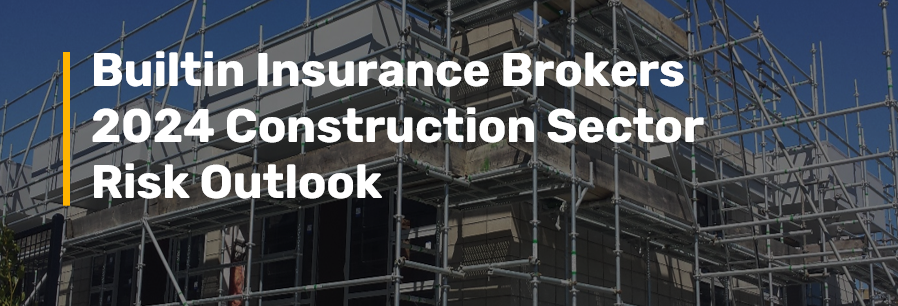In our annual outlook for the New Zealand construction sector, we outline what we think the sector is going to experience over the coming year. The report includes what you can do to both be prepared for threats and take advantage of opportunities.
The tone of this assessment is more downbeat than last year in terms of the next 12, but again with strong underlying fundamentals and green shoots on the horizon.
As a risk-focused business, we believe that being well prepared for challenges (in our language, that means identifying and mitigating risks) allows businesses to better ride out difficult periods. Having a good risk management plan in place means businesses can focus on what’s most important, enabling them to identify and target areas of opportunity and improve their overall business health. Good operators will always survive and come out stronger when the tide turns.
Over the next 12 months, business operators must closely monitor their key financial metrics, conducting more frequent updates with their financial advisers and accountants. This will serve as an early warning system and enable swift action to be taken if indicators start to turn negative. Now is also the time to implement a comprehensive risk management plan across your entire business. This will assist you in addressing potential threats to your success that haven’t already been identified.

Observations
Inflation
This was cited by builders as the number one financial issue affecting their business in 2023. Globally inflation is easing back and this is the same in New Zealand. While still high (5.6% in the 12 months to September 2023) compared to recent history (it was 1.4% in 2020 and 4.9% in 2021) it is going in the right direction (down from 7.2% at the same time in 2022). At the same time median wages increased 7.1% to June 2023, so this should have the effect of loosening up those purse strings that were closed when inflation was at its worst.
Interest Rates
These are also still relatively high compared to recent historical levels. The benchmark OCR is at 5.5% (it was 4.25% the year before and had previously been at less than 2% since 2016 until May 2022). Experts are divided on which way rates will go in 2024. Some believe that inflation is under control and the economy will struggle in 2024, so a rate cut is likely. Others say migration is boosting demand, the second hand housing market is turning a corner and interest rates still have room to move. Even without an actual reduction, as pressure to increase the rate eases we can expect banks to compete for business by dropping their own prices.
The challenge is how soon this will happen and how much longer borrowers can sustain relatively high repayments in an environment when consumer prices are also still increasing, albeit at a slower rate. We expect to see an increase in mortgagee sales through 2024 as result, making for another challenging year for house builders.
Input Costs
Construction cost growth has eased, running at 5% in Q3 vs 7.8% in Q2 of 2023 and a peak of 10.4% in late 2022. This compares well with the 10-year average of 4.5% according to Core Logic. Low margins were a key issue for builders in 2023, so addressing this will be a challenge for 2024 (and beyond).
Change of Government
Confidence has an important role to play in any economy and New Zealand’s recent change of Government is likely to give this a bump in 2024. In addition, new initiatives to stimulate construction activity are likely. However, these may be more in the area of removing red tape and reducing compliance costs, which tend to have a longer pay off, than in actual investment in new projects. Indeed, it is quite possible that the previous Government’s spending plans could be rowed back, resulting in a reduction in Government support to the sector in the short term, most notably Kainga Ora’s house building programme, which has supported a significant portion of the residential building sector over the past few years.
Immigration & Workforce
A record number of new migrants arrived in New Zealand in the year to 30th November 2023, up 135% compared to the prior year. 249,500 arrivals were offset by 122,100 departures, resulting in net migration of 127,400. While focused on Auckland, this is likely to both increase demand for housing and increase the supply of much needed skilled labour to the industry, easing pressure on wages.
Motivating and engaging existing staff and acquiring new talent remain some of the most significant challenges to organisations in the construction industry, and this is set to continue. Businesses will need to ensure that, as more women enter the industry and as workplaces become more diverse, an environment of inclusiveness is fostered, so that workers from all backgrounds are made to feel part of the team.
Industry Debt
Merchants are carrying a lot of debt, particularly from residential builders. Those with tough credit control policies are collecting at around 90%, but others are holding significant amounts of aged debt, with some carrying accounts in excess of $1m for fear of precipitating a liquidation and being forced to write off the entire debt. Similarly to households builders are likely to have been eating into their savings over the past 12 months to service debt. This is likely to come to a head in 2024 as those savings run out. As a result, expect to see a spike in company liquidations from the construction industry, which were already trending up in 2023, through 2024.
Housing
The second hand housing market starting to pick up again, with some growth expected over 2024, although this will vary regionally. Combined with the factors above this should also improve the demand side for new home construction. While consents were down 17% in the 12 months to August 2023 the actual numbers are still strong compared to 4 years ago. Commencements are forecast to increase through 2024 according to BCI.
However, work in progress pipelines and order books have shrunk over 2023 and group house builders are struggling, with some reporting a 60% drop in orders. Others are pivoting towards a price message and are well capitalised, so will be able to ride out the storm. Those that are carrying too much debt in spec homes and land that isn’t selling will be in for a tough time in 2024, having already burned through their cash reserves in 2023. Expect this to drive an increase in debt defaults and liquidations through 2024.
This makes lending and investment into the sector an ongoing challenge. As capital tightens we will see fewer developers investing in large, complex apartment projects within cities and a swing back towards less risky single level housing on greenfield land around the city’s edge.
Which way the housing sector goes in 2024 is finely balanced. We suggest the effect of 6 key factors will determine this:
- The speed and scope of government initiatives
- market confidence (driven by global as well as local events)
- interest rates
- the performance of the real estate/second hand housing market
- build costs
- land affordability
Commercial Building
This sector has been performing well but is expected to slow through 2024, with new commencements dropping below $200m in Q3 of 2023 and showing volatility across the first half of 2024 according to BCI. Investment is slowing and there is uncertainty about the level of continued Government investment in infrastructure projects.

Opportunities
The key to weathering the next 12 months will be taking appropriate action to mitigate risk and to pivot to where the opportunities are. This will ensure a business’s continued financial health by offsetting declines in “business as usual” operations until the market returns to growth.
Stay Close To Your Customers
Reconnect with your customers, be helpful, listen to them. Don’t push, recognise that the work may not be there now, but it will be there in the future. This is how you will build trust and enhance your reputation. While larger projects may be postponed there can often be a latent desire to do something sooner, so a more modest scope of work could be appealing or a project split into stages. Be front of mind as the market improves and customers are ready to spend again.
Immigration means in New Zealand’s population is becoming more diverse, with different groups having different cultural practices and living arrangements. This presents opportunities to meet the needs of new groups of people, for example by providing more houses with living space for grandparents, or through particular design preferences and features. Can you identify and capitalise on these market segments in your area?
Be Visual
Don’t sit back in your bunker, get out there and be visible. Can you start or contribute to some local projects that will generate goodwill? Sponsorship at a local level, such as with sports clubs and other organisations, can be very cost effective and will pay off as other sponsors withdraw. What is your site signage like? This is a good opportunity to revamp it.
Increase Communication
Again, this is about being seen to be helpful to your market. For larger firms this may include publishing content via LinkedIn. For smaller builders, can you produce a newsletter and distribute this locally? This can also be a good chance to build a portfolio of past projects and testimonials from satisfied customers and then update your website and social media content. Do you know all your local architects and other specifiers, and more importantly, do they know you?
Review Your Target Market
Reassess what you’re best at and focus on that area. When the work comes easy there are often lots of untapped opportunities that can be mined when times get tougher. Do you have a particular area of expertise or work that you especially enjoy or is more profitable? Tailor your communication to these areas. Identify and target niches. Often a specific message aimed at a smaller market is more effective in unlocking opportunities than more generic messaging to a wider audience. For example, refitting spare bedrooms into home offices, or building detached home office spaces.
Conversely, are there other areas that you have the skillset to go after? Could you target commercial fit outs in addition to residential renovations? Do you have the space, time and capital to build and sell tiny homes given the continued growth in this market?
Add Value
This could be little things that don’t cost much money but have a big impact on how customers perceive you. Do you supply maintenance guidelines (as you’re required to do) in a format that is easy for customers to refer to? Do you offer a maintenance service or schedule post-completion reviews/walk throughs? Sending scheduled reminders to clients when their maintenance is due is, or recommending services such as Gtee (gteeco.com), is often very much appreciated and could prompt additional work.
Monitor Your Financial Position Closely & Cut Costs Smartly
Regular monitoring of key financial performance metrics, particularly cashflow, and early, proactive intervention when an issue is identified is critical.
Examine your costs and look for areas that can be trimmed or renegotiated. It’s better to do this in advance than have to be reactive when cashflow is under pressure. Do you have sufficient financial expertise to know how your business is really doing, or are you supported by professionals that will give you this advice in a timely manner? What types of projects have the best margins? Do you have too many vehicles? Can you sell some and switch to a leased approach? Are there inefficiencies in your build programme that can be tidied up? Can you re-tender or renegotiate your subcontract work, including adding penalties for poor performance, such as cancellations and delays that cost you money?
A Continuous Improvement Mindset
You might be the best at something today, but if you don’t continue to work at it you won’t be for long. This mindset of continuous improvement is key to success, especially when the market is tough. Investing in staff training and new technology on an incremental basis is more effective than slipping behind the market and having to play catch up. Ask yourself, what skills do your staff lack that would benefit your business? What systems in your business are cumbersome and inefficient that could be upgraded?

Take Advantage of Trends
In any sector experiencing a slowdown there are always pockets of work that buck this trend and will be growing. If you can take advantage of these trends then your business will do well even as the overall market struggles.
Disaster Recovery
Cyclone Gabrielle, floods and other natural disasters over recent years raised awareness of the effects of a changing climate on our lives and livelihoods. The insurance industry is at the sharp end of this, with 2023 being the largest year on record for claims. We saw substantial enquiry from builders wanting to take part in flood remediation work last year as other areas of the sector softened. While much work has been completed, there is still plenty to do.
Following the severe weather events in 2023 the Government introduced property risk categories, which will likely drive new building and resource consent requirements for affected properties and areas. This will flow through to investment in mitigation measures, at both a community level, such as improved flood defences, and at an individual level, with changes to drainage requirements and minimum floor levels.
The same applies to earthquake strengthening, which is an ongoing area of work. Can you position your business to take advantage of requirements to improve flood, coastal inundation and storm mitigation measures?
Green Buildings
Occupier demand for green/sustainable commercial buildings is growing. The same trend exists for residential homes. And as construction and energy costs rise the return on investment from a green building, with its much lower energy consumption over time, becomes even more attractive. There are a number of institutional investors and funds that are focused on this area, Government regulation is likely and Government funded projects are likely to include sustainability requirements. This includes both the construction of new and retrofitting of existing buildings. Can you position your business to be well placed to win contracts in this growing market?
Medium Density Housing
The demand for apartments and other multi-unit homes has increased significantly over the past decade and this trend is likely to continue. Can you pivot your business from standalone homes towards one or more of the categories of multi-unit buildings: 1-2 storey duplex and semi-detached attached houses; 2-4 storey terraced housing and 3-6 storey apartments?
Accessible Buildings
In New Zealand 1.1 million people (around 24% of the population) are reported to have a disability (this could be both a permanent or temporary condition). Globally, there is an increasing trend towards designing buildings that are accessible for people with a disability, with regulatory rules existing here that require “reasonable and adequate provisions” be made for persons with disabilities. As the population ages more homes will need to include accessible facilities. Can you position your business as an expert in accessibility solutions, including new buildings and retrofitting existing dwellings and commercial premises?
Tiny Homes/Modular Construction
Demand for tiny homes is continuing to grow, as is the move towards modular and offsite construction. This trend is here to stay, can you position your business to take advantage of these trends?
Technology
Adoption of digital technology in the construction sector aims to improve experience for clients during both the design and build phases, as well improving efficiency and lowering costs for builders. Tenders, designs and workplaces that incorporate this technology will stand out from the crowd. Adoption of these new systems by staff that may not be naturally tech savvy is one of the challenges builders will face over the coming years.
One example is building information modelling (BIM), which enables collaboration between all the stakeholders in a construction project right across the project lifecycle, from planning to construction to occupancy and maintenance. It enables more efficient design, site planning and scheduling. It also drives costs savings through every part of the project, including by minimising waste and energy consumption.
Another example is the use of data analytics, and increasingly artificial intelligence, to enable better decision making across all aspects of business.
Robotics and automation will increasingly feature in the New Zealand construction sector, with 3D printing bringing accuracy, safety and cost benefits.
Would you consider your business to be at the forefront of the adoption of technology? If not, how could investment in this area help your business win new customers?
Materials Innovation
New Zealand’s Emissions Reduction Plan requires that by 2050 we have “a circular economy that keeps materials in use for as long as possible”. This could include using building waste to produce new building products and waste plastics being incorporated into concrete and non-structural panels. SaveBoard upcycles packaging to produce building materials such as internal linings with much less embedded CO2 to standard alternatives. Additionally, more engineered wood-plastic composite products are being developed and LVL/CLT prefabrication is replacing steel in some larger building projects.
Both customer demand and regulation are likely to increase demand for these materials, can you develop and promote expertise in this area as an aspect of your business?
Safety
A focus on safety across the industry is ongoing, so expect no let up in 2024. A change in mindset from safety as a compliance issue to safety as a habit continues. While technology will play a role here, there is no substitute for developing a culture of safety. It is also a non-negotiable when it comes to winning business via competitive tender. What do you need to do to both establish a safety-first culture and use this as a way to win both new customers and attract and retain workers?
New Energy Sources for Domestic Buildings
Clean, sustainable and locally generated energy is increasing in both importance and demand from consumers. Adding value by suggesting alternative options to traditional energy sources will help differentiate you from the market. This could include solar but extend to hydrogen storage, sand batteries and bladeless turbines.

Conclusion
While 2024 looks like it will be a challenging year for the industry, if your business is well led it will weather these challenges and come out the other side stronger. Our main message is to be proactive and make decisions before they are forced on you. Re-evaluate your business, make sure you have good understanding of the risks you face and have plans in place to manage these. Seek professional advice to assist where you need it and position yourself to take advantage of opportunities.
This article was written by Ben Rickard, Construction Risk Adviser and Director at Builtin Insurance Brokers. Builtin have more than 2,500 customers nationwide and 20 years experience providing insurance and risk management services to the construction industry.
References




